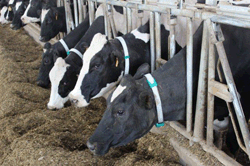When looking for ways to improve milk production or components oftentimes the focus is placed on adjusting small items in the ration, like increasing grams of metabolizable protein or metabolizable Lysine. But, frequently it's the big picture items that offer the biggest areas of improvement, says Dr. Frank Janicki, technical sales specialist with Purina Animal Nutrition LLC.
 "Before any ration adjustments are made it's important to take a 30,000 feet look at the dairy," he advises, noting that there are many non-feed related issues that impact milk production. "Purina Animal Nutrition Center research tells us that 35 percent of what contributes to fat corrected milk production is related to non-feed issues. In the real world it's probably closer to 50 percent."
"Before any ration adjustments are made it's important to take a 30,000 feet look at the dairy," he advises, noting that there are many non-feed related issues that impact milk production. "Purina Animal Nutrition Center research tells us that 35 percent of what contributes to fat corrected milk production is related to non-feed issues. In the real world it's probably closer to 50 percent."To make sure non-feed related issues aren't an issue when evaluating milk production potential, Janicki advises producers and nutritionists use these five tools:
1. Penn State Shaker Box (forage particle separator)
The Penn State Shaker Box provides information on how the feed is being delivered to the cow. This, Janicki points out, is directly related to rumen health and cud chewing.
"The Penn State Shaker Box can give you insights on whether enough effective fiber is being provided in the diet, particle length, TMR mixing efficiencies and if the cow is likely to sort the ration or not," he says. "You want a ration, in terms of particle length, that's not too fine and not too coarse." Guidelines for a TMR are 2 to 8 percent on the top screen, 30 to 50 percent on the second screen, 30 to 50 percent on the third screen and < 20 percent in the bottom pan.
2. 1/16" Screen
Whether you grind corn or buy ground corn there is variation in fineness. If corn isn't ground properly, it will not be used efficiently by the cow.
Janicki suggests taking a sample of the ground corn and running it through a 1/16" screen to see how well the corn is ground. "A very practical tool you can use is found in your kitchen - a flour sifter or strainer. If more than 90 percent of ground corn passes through this size screen the grind is considered excellent. Eighty to 90 percent passing is considered very good. Seventy to 80 percent is considered good and <70 percent definitely needs improvement," he says.

"Feeding corn that is ground too coarse results in decreased ruminal starch degradability and potential loss of milk production and decreased feed efficiency. Feeding too much corn that is ground too fine can result in increased ruminal starch degradability which can potentially result in decreased intake, off-feed issues, milk fat depression and lost milk production," he says. "There is a large variation in corn grind from farm to farm. You need to know what you are working with when putting a ration together," he says.
3. Dial or digital thermometer with a 12 to 18" probe
A thermometer probe can be an effective tool to evaluate forages in bunker or drive-over piles, helping to determine if proper packing and feed out steps are being taken.
"If the face of the silage pile is heating, secondary fermentation is taking place and the feed is likely spoiling before it reaches the cow," notes Janicki. "You want the silage to be as fresh as possible." If the silage is heating before it gets to the cow, yeasts and molds are growing and the feed loses its nutritional value.
Safety is always of the utmost concern when working with silage, so be very cautious when measuring the temperature of the silage face. It may be safer to scrape and deface the bunker, then measure the temperature in the loose forage.
4. Evaluate fecal starch content
A composite manure sample can be collected and submitted to a laboratory for evaluation of the fecal starch content. Fecal starch content should be less than 4 to 5 percent. According to University of Pennsylvania research, for every point higher the farm is losing 0.7 pound of milk. "I've seen farms with fecal starch contents ranging from 9 to 12 percent. That's a lot of lost opportunity," he adds.
A 3/16" screen can also be used to wash a manure sample to subjectively evaluate the amount of whole or partially digested kernels passing through in the manure. A lot of kernels from unprocessed or poorly processed silage or corn particles (grit) can indicate that corn is not being well utilized by the cow. "Look for oilseeds (whole cottonseed and roasted beans) passing through, too," says Janicki.
Washed manure is also evaluated for fiber particles. "If you see longer particles in the manure, the rate of passage out of the rumen might be too fast," he says.
5. Body Condition Scoring
Body condition scoring is another tool that can give an indication if a ration is optimal. "Keep an eye out to make sure cows aren't losing too much body condition in early lactation or putting too much on in late lactation or during the dry period," says Janicki. Body condition scores should be evaluated throughout the lactation.
Once all five of these tools have been effectively implemented, then start looking at the diet in terms of ingredients, technologies and products. "Fine tuning the ration comes after the big picture has been evaluated," says Janicki.
And, while these five tools won't be used every month, they should be re-evaluated every couple months to make sure things are still on track or when things change on farm.
Remember, it should always be top of mind to feed every cow, exactly what she needs, where she needs it, when she needs it nothing more and nothing less. This approach will aid dairy farmers in capturing opportunities for improved efficiency.
For more information, contact Dr. Frank Janicki at (717) 737-6735 or email: FJJanicki2@landolakes.com.
Purina Animal Nutrition LLC www.purinamills.com is a national organization serving producers, animal owners and their families through more than 4,700 local cooperatives, independent dealers and other large retailers across the United States. Driven by an uncompromising commitment to animal excellence, Purina Animal Nutrition is an industry innovator, offering America's leading brands of complete feeds, supplements, premixes, ingredients and specialty technologies for the livestock and lifestyle animal markets. Headquartered in Shoreview, Minn., Purina Animal Nutrition LLC is a wholly owned subsidiary of Land O'Lakes, Inc.
01.16.2013